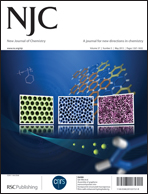The nature of lead–sulfur interaction in [PbII(S2COEt)n]2−n (n = 1,2,3,4) complexes: topological exploration and formation analysis†
Abstract
The electronic structure and the nature of Pb–S interaction in the [PbII(S2COEt)n]2−n (n = 1,2,3,4) complexes are investigated theoretically. The ELF analysis has been performed for qualitative assignment of position, shape and directionality of the valence basin V(Pb) of lead in these chelates. The Pb–S interaction is explored in the light of AIM formalism and NBO analysis. In all these complexes, lead mainly uses its 6p sub-shell to coordinate with the 3p sub-shells of S-atoms. In the [Pb(S2COEt)2] (n = 2) and [Pb(S2COEt)3]− (n = 3) complexes, significant participation of 6d and 7s orbitals of lead is also observed. As lead mainly uses the 6p orbitals in coordinating with the sulfur atoms of
![Graphical abstract: The nature of lead–sulfur interaction in [PbII(S2COEt)n]2−n (n = 1,2,3,4) complexes: topological exploration and formation analysis](/en/Image/Get?imageInfo.ImageType=GA&imageInfo.ImageIdentifier.ManuscriptID=C3NJ41105B&imageInfo.ImageIdentifier.Year=2013)

 Please wait while we load your content...
Please wait while we load your content...